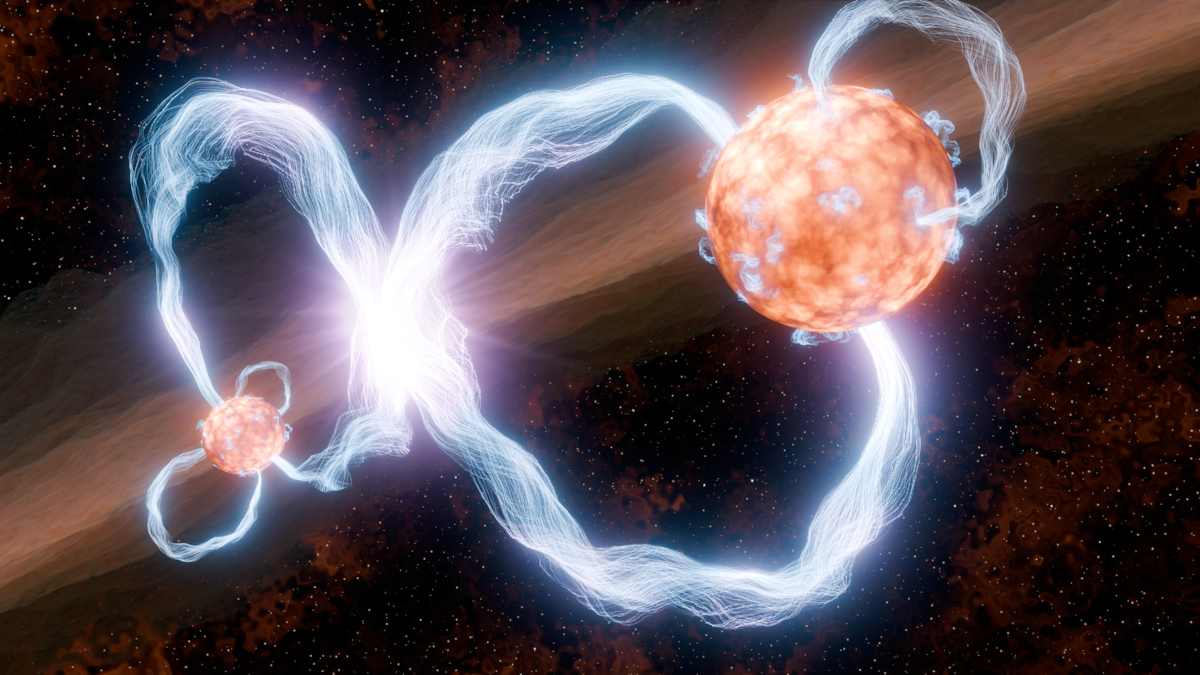
 Credit: NASA/JPL-Caltech/R. Hurt (IPAC)
Credit: NASA/JPL-Caltech/R. Hurt (IPAC)
Activity in Proximity
Most of the stars in our galaxy exist in binary or multiple star systems, gravitationally bound to one (or more) companion stars, each revolving around their common centers of mass, blissfully following the laws of Johannes Kepler. In this regard, our Sun, an apparently single star, appears to be an outlier. Binary (and multiple) star systems are thought to be formed by the fragmentation of large interstellar clouds of gas and dust, if the fragments are massive enough to hold themselves together by the force of their individual gravity and near enough to begin to orbit each other. A particularly interesting cosmic test case is the binary system called DQ Tau, which consists of two gravitationally bound protostars. Protostars are young stars still in the process of gravitational contraction, that have not yet ignited the thermonuclear furnace in their cores that will power them for the rest of their multi-billion year lives. As protostars collapse, they begin to spin faster and faster due to the conservation of angular monmentum, and internal heat creates organized motions of the plasma inside the protostar, a perfect recipe for generation of strong magnetic fields. These magnetic fields can be powerful enough to drive narrow jets of charged particles from the star enormous distances into space, and produce strong stellar magnetic storms, flares and ejections of matter (much like the magnetically-drive activity on our own Sun). In the case of DQ Tau, however, stellar activity and stellar flares are also influenced by the motions of the two protostars revolving in their elliptical orbits. In elliptical orbits, the separation between the two stars varies. In the case of DQ Cep interactions between the protostellar magnetic fields drives enhanced magnetic activity when the two stars are close together, producing eruptions of high-energy emission in X-rays. A recent study of X-ray emission from DQ Tau by the X-ray telescopes on NASA's NuSTAR, Swift and Chandra X-ray observatories showed that the close interactions of the two protostellar magnetic fields drives most of the magnetic activity from the system, and produces X-ray "superflares" from tangled magnetic loops stretching more than 10 times the size of the stars themselves.
Published: September 30, 2024
<
HEA Dictionary ● Archive
● Search HEAPOW
● Other Languages
● HEAPOW on Facebook
● Download all Images
● Education ● HEAD
>

Each week the HEASARC
brings you new, exciting and beautiful images from X-ray and Gamma ray
astronomy. Check back each week and be sure to check out the HEAPOW archive!
Page Author: Dr. Michael F. Corcoran
Last modified Friday, 11-Oct-2024 16:57:26 EDT


